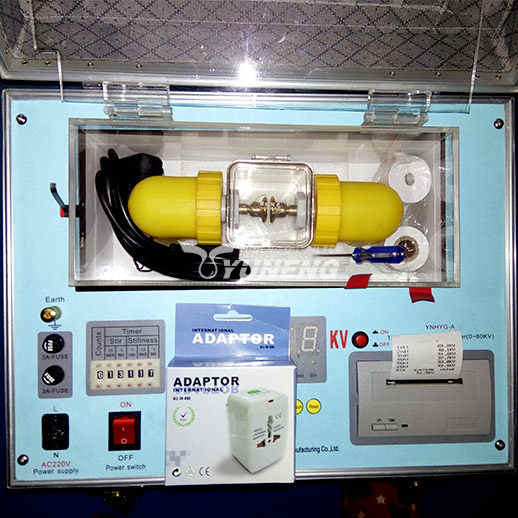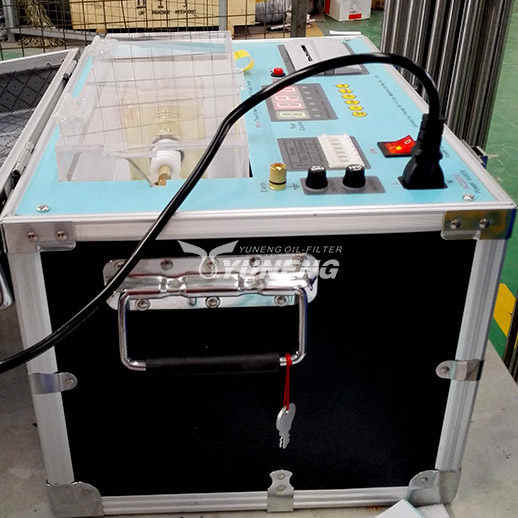Transformer Oil BDV Tester: A Vital Tool for Power Grid Reliability
Transformers are the unsung heroes of the modern world, silently siphoning high-voltage electricity down to manageable levels for our homes and businesses. But within these complex machines lies a crucial element: transformer oil. This specialized oil acts as a coolant, insulator, and stress reliever, ensuring the smooth operation of the transformer. However, just like any component, transformer oil can degrade over time, potentially compromising its insulating properties. This is where the transformer oil breakdown voltage (BDV) tester comes in – a vital tool for assessing the health of the oil and preventing catastrophic transformer failures.

What is a Transformer Oil BDV Tester?
Imagine a device that can measure the strength of an invisible shield. That’s essentially what a transformer oil BDV tester does. It applies a progressively increasing voltage to two electrodes immersed in a transformer oil sample. When the voltage reaches a point where the oil’s insulating capacity fails, a spark jumps between the electrodes, indicating the breakdown voltage (BDV) of the oil. This voltage, measured in kilovolts (kV), tells us how well the oil can resist electrical stress before breaking down and potentially causing internal short circuits.
How Does the Transformer Oil BDV Tester Work?
Beneath the unassuming exterior of a transformer oil BDV tester lies a symphony of intricate processes, each choreographed to assess the oil’s vital insulating capacity. Let’s peel back the layers and delve into the fascinating heart of this crucial instrument:
1. Sample Preparation: A Crucial First Step
The journey begins with meticulous sample collection. Using dedicated sampling ports, technicians extract a representative oil sample from the depths of the transformer. To ensure its integrity, the sample is handled with utmost care, avoiding contamination that could skew the results. Temperature becomes a pivotal player here. Fluctuations can significantly impact the breakdown voltage, so most testers boast sophisticated temperature control systems. They precisely maintain the oil within a specified range, often around 25°C, mimicking the operating conditions within the transformer itself.
2. Electrode Calibration: Precision at its Finest
Next, the stage is set for the electrical showdown. Two electrodes, crafted from carefully chosen materials like stainless steel or brass, are immersed in the oil bath. Their positioning is no mere coincidence. A precisely controlled gap separates them, ensuring a consistent electric field distribution within the oil. Imagine this gap as a canyon across which the voltage will attempt to bridge. Any deviation in distance alters the “jump rope” length, potentially yielding inaccurate results.
3. Voltage Ramp-Up: The Building Tension
Now, the voltage generator steps into the spotlight. With measured deliberation, it gradually increases the voltage applied across the gap between the electrodes. This ascent follows a carefully calibrated rate, often around 2 kV per second. Think of it as a slow, calculated climb towards the edge of a precipice. With each tick of the voltage, the pressure on the oil’s insulating properties intensifies.
4. Breakdown Detection: The Moment of Truth
As the voltage climbs, the oil is stretched to its insulating limit. It’s a tense standoff between the rising electrical force and the oil’s desperate grip. The moment the tension snaps, a spark erupts across the gap, declaring the oil’s defeat. This breakdown signifies the point at which the oil can no longer resist the electrical stress, marking the crucial breakdown voltage. The tester, acting as a watchful observer, instantly halts the voltage ramp-up and meticulously records this critical value.
5. Data Analysis: The Final Act
The breakdown voltage isn’t just a trophy; it’s a vital diagnostic clue. The tester, wielding its analytical muscle, compares the recorded value against established standards for healthy transformer oil. This comparison forms the basis of a definitive verdict: is the oil fit for continued service, or has it reached its twilight years? By revealing the oil’s true capacity to withstand electrical stress, the BDV tester provides technicians with the crucial information they need to safeguard the health and performance of our vital transformers.

Taming the Electrical Beast: Safety Precautions for the Transformer Oil BDV Tester
While the transformer oil BDV tester might appear like a straightforward tool, it wields the power of high voltage. To ensure safe and accurate operation, it’s crucial to treat it with respect and follow these vital precautions:
1. Heeding the Master’s Instructions: Each tester is a unique beast, with its own dialect of operating procedures and safety protocols. Ignoring its manual is like waltzing into a lion’s den without a tamer – a recipe for disaster. Familiarize yourself thoroughly with the specific instructions, paying close attention to voltage limits, grounding protocols, and emergency shut-down procedures.
2. Grounding the Unseen Threat: Electricity is an invisible force, and its wrath can be swift and unforgiving. Ensure all equipment, including the tester itself, is properly grounded to a reliable earth point. This creates a safe escape route for stray currents, preventing them from seeking an unintended path through you or your colleagues.
3. Cleanliness is Next to Accuracy: Contamination is the enemy of precise measurements. Before each test, meticulously clean the test cup, electrodes, and oil sample. Even a tiny speck of dirt or moisture can distort the results, leading to false readings and potentially compromising the health of your transformer.
4. Temperature: The Delicate Dance: Transformer oil, like any diva, performs best under specific conditions. Most testers require the oil to be within a narrow temperature range, often around 27°C. Deviate from this sweet spot, and the breakdown voltage reading becomes a fickle whisper, unreliable, and misleading. Invest in a good thermometer and adjust the temperature accordingly for accurate results.
5. Interpreting the Oracle’s Verdict: The breakdown voltage is the key the tester unlocks, revealing the oil’s true health. But deciphering its meaning requires expertise. Compare the measured value to the manufacturer’s recommendations for the specific type of oil and transformer. A low BDV reading could be a siren song, hinting at contamination, degradation, or simply the wrong oil for the job. Don’t hesitate to consult a qualified technician if the reading throws up red flags.
Remember, the transformer oil BDV tester is a powerful tool, not a toy. By following these precautions and treating it with the respect it deserves, you can harness its power to ensure the health and safety of your transformers, keeping the lights shining bright and the electrical gremlins at bay.

Summary
The transformer oil BDV tester is a critical tool for maintaining the health and safety of transformers. By regularly monitoring the breakdown voltage of the insulating oil, technicians can identify potential problems early, prevent costly downtime, and ensure the reliable operation of these vital electrical workhorses. Remember, a healthy transformer oil shield keeps the electricity flowing smoothly and our world powered up.

